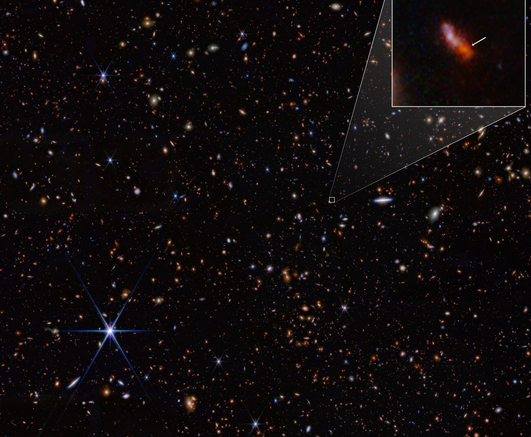Using the NASA/ESA/CSA James Webb Space Telescope, scientists have found a record-breaking galaxy observed only 290 million years after the big bang.
Over the last two years, scientists have used the NASA/ESA/CSA James Webb Space Telescope to explore what astronomers refer to as Cosmic Dawn – the period in the first few hundred million years after the big bang where the first galaxies were born.
These galaxies provide vital insight into the ways in which the gas, stars, and black holes were changing when the universe was very young. In October 2023 and January 2024, an international team of astronomers used Webb to observe galaxies as part of the JWST Advanced Deep Extragalactic Survey (JADES) programme. Using Webb’s NIRSpec (Near-Infrared Spectrograph), scientists obtained a spectrum of a record-breaking galaxy observed only two hundred and ninety million years after the big bang.
This corresponds to a redshift of about 14, which is a measure of how much a galaxy’s light is stretched by the expansion of the Universe.
This infrared image from Webb’s NIRCam (Near-Infrared Camera) was captured as part of the JADES programme. The NIRCam data was used to determine which galaxies to study further with spectroscopic observations. One such galaxy, JADES-GS-z14-0 (shown in the pullout), was determined to be at a redshift of 14.32 (+0.08/-0.20), making it the current record-holder for the most distant known galaxy. This corresponds to a time less than 300 million years after the big bang.
In the background image, blue represents light at 0.9, 1.15, and 1.5 microns (filters F090W + F115W + F150W), green is 2.0 and 2.77 microns (F200W + F277W), and red is 3.56, 4.1, and 4.44 microns (F356W + F410M + F444W). The pullout image shows light at 0.9 and 1.15 microns (F090W + F115W) as blue, 1.5 and 2.0 microns (F150W + F200W) as green, and 2.77 microns (F277W) as red.
These results were captured as part of spectroscopic observations from the Guaranteed Time Observations (GTO) programme 1287, and the accompanying MIRI data as part of GTO programme 1180.
Learn more about these results here.
[Image description: A field of thousands of small galaxies of various shapes and colors on the black background of space. A bright, foreground star with diffraction spikes is at lower left. Near the image center, a tiny white box outlines a region and two diagonal lines lead to a box in the upper right. Within the box is a banana-shaped blob that is blueish-red in one half and distinctly red in the other half. An arrow points to the redder portion and is labeled “JADES GS z 14 – 0”.]

Credit: NASA, ESA, CSA, STScI, B. Robertson (UC Santa Cruz), B. Johnson (CfA), S. Tacchella (Cambridge), P. Cargile (CfA)
Source: ESA





Be the first to comment on "Webb finds most distant known galaxy"